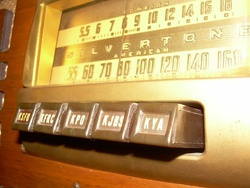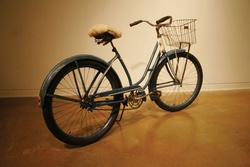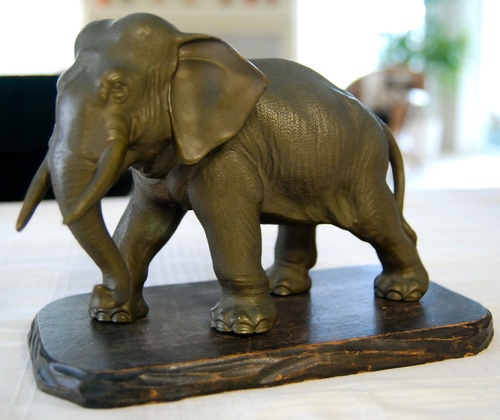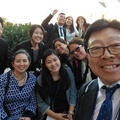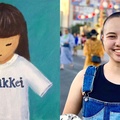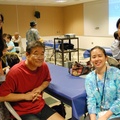Over the holidays, I was telling my niece about American Tapestry: 25 Stories from the Collection, the current exhibition at the Japanese American National Museum.
Two of my favorite artifacts from the exhibition are the 1939 Silvertone American short wave radio and a navy blue Schwinn bicycle with a lambskin seat cover. Both have similar heartwarming stories of friendship. Both were owned by Japanese American families prior to World War II and entrusted with friends, but never reclaimed after the war.
In the case of the radio, they were never able to locate the original owners. The father gave it to his daughter, sharing its story. The daughter decided to donate it to the Museum, but shared its story with her sons first so they would learn from the lessons of the past.
After more than 60 years, the bicycle found its way back to its original owner. Yoshino Uyemaru and her family were sent to Gila River in Arizona during World War II. Her father gave the bike to her good friend Alice Blueian, but Alice’s father always impressed upon her that someday she must find Yoshino and giver her back the bike. After the war and subsequent years, the girls lost track of each other. Alice placed ads in newspapers and was finally able to track down her long lost friend and return the bike.
As I talked about these stories, my mother-in-law recalled a similar story about the “Tsuda elephant.”
In my mother-in-law’s home, there stands a small metal elephant atop the television cabinet. Elephants are symbols of wisdom, known for their memory. It’s essential for their survival to recognize others from their group—to remember their friends and comrades. It’s also vital to recall and find locations with water and food. If only this mysterious elephant could share its memories with us.
Prior to World War II, my father-in-law Roger was a young child in Dos Palos, California where his father worked on the Koda family rice farm.
When the family was forced to leave their homes and communities like other Japanese Americans across the West Coast, they faced decisions on what to bring with them and what to leave behind. They were eventually taken to the Jerome concentration camp in Arkansas. From there, with the help of his aunt who found his father a job in Washington D.C., they were able to leave camp early. Roger grew up in Washington D.C. The family eventually returned to California, but never returned to Dos Palos.
In 2000, Roger’s sister Carol received a package. Inside was a mysterious elephant with a typewritten letter.
My brother Jon and I attended South Dos Palos Elementary School from October 1939 through the end of school 1942. These were my second, third, and fourth grades. Brother Jon was a grade behind me, and you and Herbert [of the Koda family] were two grades ahead of me. My sister Sally followed me by three years and was in the first grade with your brother Roger.
Our mothers were both very involved in volunteer work at the school doing whatever the two teachers needed help with. I remember them making costumes for the school plays, helping at school parties, etc. At the time it did not seem like much, but looking back it must have been a rather extensive involvement.
You may recall, I spent a lot of time at the rice mill playing with Herbert. We fished in the canal, played tops on the warehouse floor, shot black birds with our BB guns, played in the rice hull pile, and many other things 10 and 11 year old boys did around rice mills 60 years ago.
Then after all this came the night before your internment departure, and my parents went over to the rice mill to say good-bye. The next morning there was the elephant, and later when I got to school Carol, Roger, and Herbert were gone. My mother explained that Mrs. Tsuda had limited space and could not take the elephant; so, she had given it to her. Over the years we have known it as the “Tsuda elephant” or just “the elephant.”
Now fast forward, perhaps 30 years, probably more. My mother who had been exchanging Christmas cards every year with your mother told me that she had written to Mrs. Tsuda and offered her the elephant back. According to my mother she had written more or less the following:
We still have the elephant.
I am certain the elephant meant more to you and your family than it does to us.
I know you parted with it during very trying circumstances.
I am grateful that you selected me to give it to, and we have enjoyed it over the years.
In light of all this, I wonder if you would like to have it back?
My mother indicated that Mrs. Tsuda had responded in the affirmative, and she had sent the elephant back to her.
I remember at the time thinking how thoughtful and considerate of her. It was something I would never have considered if I was charged with the disposition of her possessions.
So fast forward again another 30 years or so, actually last fall, when my wife was helping my mother clean out a bedroom closet, and there appeared the elephant or its twin. Well, the Tsuda elephant would not have a twin in Dos Palos, at least not after 60 years. I realize that with older people good intentions often become an accomplished fact, and I have seen this over and over again with my mother.
Therefore, what do I do? My mother had offered it, and Flora had said she would like it back. Are Barry and Flora still alive, if so, what is their address? How about Carol? Her name is probably not Tsuda any more. What about Roger? He will be my only contact if I have to go the internet route. But first I go through my mother’s hodgepodge of old correspondence and find a 1972 letter from your mother with no address and a 1965 address in Gardena. I figure this is all too old, but Ed Koda, my father’s old high school advance math student is still around. Last fall I ran out of time, but this trip I was able to contact Ed Koda, and so here we are Carol after 58+ years.
The elephant bears a few scars from being on display for years on my little brother Eric’s dresser. In fact the orange paint on the bottom of the stand came from his dresser. I apologize for my mother not carrying through with her offer those many years ago.
I hope this arrives OK. It will be a big load off my mind.
By the time the elephant arrived, Roger’s parents had passed away. Neither children even remembered seeing the elephant before. They could only guess at its significance to their mother and how she came to own such a thing. Was it a gift? Was it a souvenir of travels? There’s no one left who can answer those questions.
If only the elephant could talk…but in a way it already has. The letter shared details about Roger’s mother and their family’s life in Dos Palos that we would never have known otherwise. Such is the power of artifacts and their stories.
American Tapestry: 25 Stories from the Collection
Through April 17, 2011
at the Japanese American National Museum
Los Angeles, California
A selection of artifacts, artwork, photographs, oral histories, and more—some of which have never been seen by the public.
Learn more about this exhibition >>
© 2011 Vicky Murakami-Tsuda


